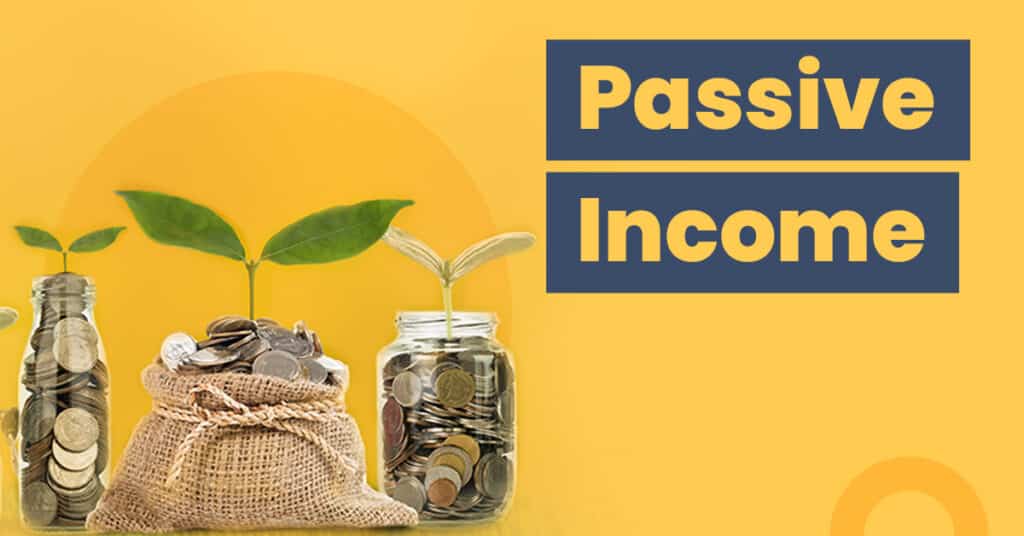In today’s world, achieving financial freedom is a common aspiration. A passive income stream can be a crucial part of this journey, allowing you to earn money with minimal ongoing effort. Passive income ideas for building wealth include investing in stocks, rental properties, creating digital products, and affiliate marketing.
This guide provides a detailed exploration of various passive income strategies, how to get started, and the potential benefits and challenges of each method.
Related: What to Invest in During a Recession
What is Passive Income?
Passive income is money earned with little to no continuous effort. Unlike active income, which requires ongoing work (like a job or side hustle), passive income involves upfront work that generates long-term returns. The IRS defines passive activities as (1) trade or business activities in which you do not materially participate, and (2) rental activities.
The allure of passive income lies in its potential to provide financial stability and freedom. Whether it’s through investments, digital products, or rental properties, passive income can offer a steady revenue stream that complements or even replaces active income sources.
Active vs. Passive Income
Active Income:
- Requires continuous effort.
- Directly tied to the amount of time spent working.
- Examples: salaries, wages, freelance gigs.
Passive Income:
- Involves initial effort, followed by minimal maintenance.
- Generates revenue over time without active involvement.
- Examples: rental income, dividends, royalties.
Getting Started with Passive Income
When considering passive income opportunities, ask yourself:
- What kind of upfront investments can I make (in terms of money, time, and effort)?
- Do I have any skills or knowledge that others may find valuable?
- How can I automate the sharing of my skills or knowledge?
Popular Passive Income Ideas
1. Financial Investments
Investing in stocks, mutual funds, bonds, or peer lending can be a lucrative way to earn passive income. Financial investments generally require minor follow-up work as they accrue interest.
Pros:
- High growth potential over time.
- Minimal maintenance.
Be mindful of:
- Limited access to funds in the short term.
- Subject to tax requirements.
2. Rental Properties
Owning rental properties can provide a steady income stream. Whether you opt for long-term tenants or short-term rentals (like Airbnb), rental income can be a lucrative investment.
Pros:
- Potential for lucrative long-term returns.
- Immediate income once renters move in.
Be mindful of:
- Responsibilities of property upkeep.
- Income dependency on having tenants.
3. Print-on-Demand Shops
Selling original designs on products like shirts, mugs, and posters through print-on-demand services (e.g., Printful, Printify) allows you to create and sell without handling inventory or fulfillment.
Pros:
- No inventory or fulfillment needs.
- Opportunity to create unique products.
Be mindful of:
- Need for self-promotion and marketing.
- Handling customer service issues.
4. Self-Publishing
Writing and self-publishing a book through platforms like Kindle Direct Publishing can be a rewarding way to earn passive income. You can sell your book in digital or print formats.
Pros:
- Complete creative control.
- Pride in sharing your knowledge or story.
Be mindful of:
- Time-consuming preparation process.
- Need for marketing and self-promotion.
5. Selling Digital Products
Creating and selling digital products such as worksheets, templates, and online courses can be a profitable venture. These products can be sold on platforms like Etsy or personal websites.
Pros:
- Easy and inexpensive to create.
- Opportunity to leverage specific expertise.
Be mindful of:
- Time required to generate noticeable returns.
- Potential sales fees from host websites.
6. Content Creation
Creating content for platforms like YouTube allows you to earn money through advertising, sponsorships, and affiliate marketing. Successful content can continue to generate revenue long after its initial release.
Pros:
- Creative control over your work.
- Long-term earning potential.
Be mindful of:
- Need to build a following.
- Regular content updates required.
Advanced Passive Income Strategies
7. Dropshipping
Dropshipping involves selling products online without holding inventory. You partner with suppliers who ship products directly to customers. Platforms like Shopify make it easy to start a dropshipping business.
Pros:
- Control over product margins.
- No inventory management required.
Be mindful of:
- Dependence on suppliers for product quality and shipping.
- Competitive market.
8. Blogging
Blogging can be a sustainable way to generate passive income through affiliate marketing, sponsored posts, and selling digital products. Building a successful blog requires significant upfront work but offers multiple income streams.
Pros:
- Multiple income streams from one asset.
- Organic and social traffic growth potential.
Be mindful of:
- Time-consuming initial setup.
- Need for ongoing content creation and marketing.
9. Creating and Selling Online Courses
If you have expertise in a particular field, creating and selling online courses can be highly profitable. Platforms like Udemy or Teachable allow you to reach a broad audience.
Pros:
- Leverage your unique expertise.
- Control over pricing and content.
Be mindful of:
- Intensive start-up process.
- Need for marketing and regular updates.
10. Stock Photos
Selling stock photos on platforms like Shutterstock or Adobe Stock allows photographers to earn passive income. High-quality, unique images are always in demand.
Pros:
- No need to find clients directly.
- Creative control over your work.
Be mindful of:
- Learning and navigating legalities.
- Potential sales fees from host websites.
Innovative Passive Income Methods
11. Creating an App
If you have development skills, creating a mobile app can be a profitable venture. Apps can be monetized through in-app advertising, premium features, and paywalled content.
Pros:
- Reach a broad audience.
- Test and develop your skills.
Be mindful of:
- Need for updates and maintenance.
- App store fees.
12. Affiliate Marketing
Promoting products and earning a commission on sales through affiliate marketing is a popular passive income strategy. Successful affiliate marketers use SEO and content marketing to maximize earnings.
Pros:
- High earning potential.
- Opportunity to promote a variety of products.
Be mindful of:
- Time required to start earning.
- Maintenance and updates to posts.
13. Buying and Flipping Websites
Experienced website developers can buy, improve, and sell websites for a profit. Platforms like Flippa provide a marketplace for website transactions.
Pros:
- Potential for high returns.
- Opportunity to leverage design and development skills.
Be mindful of:
- Initial investment and time commitment.
- Need to generate revenue to prove potential.
Real Estate and Physical Assets
14. Investing in Real Estate
Buying and holding rental properties or investing in real estate investment trusts (REITs) can provide consistent passive income and potential appreciation.
Pros:
- Steady rental income.
- Potential property value appreciation.
Be mindful of:
- Upfront investment required.
- Property management responsibilities.
15. Vending Machines
Investing in vending machines can be a straightforward way to earn passive income. After the initial setup, vending machines require minimal maintenance.
Pros:
- Steady income stream.
- Minimal ongoing effort.
Be mindful of:
- Initial investment in machines and inventory.
- Finding and securing locations.
Digital Products and Licensing
16. Licensing Art or Designs
Artists can license their work to companies for use on various products, earning royalties on sales. This allows artists to earn from their creations without ongoing effort.
Pros:
- Ongoing income from existing work.
- Reach a broad audience through licensing deals.
Be mindful of:
- Finding companies interested in your designs.
- Negotiating fair licensing terms.
17. Creating Audio Tracks
Musicians and sound designers can create and license audio tracks for use in media projects. Platforms like SoundCloud and Audiosocket provide opportunities to earn royalties.
Pros:
- Passive income from creative work.
- Potential for long-term royalties.
Be mindful of:
- Understanding market demand for audio content.
- Initial time investment in creating tracks.
Final Thoughts on Building Passive Income
Creating passive income streams requires an upfront investment of time, money, or effort, but the long-term benefits can be substantial. Whether you choose to invest in financial markets, create digital products, or explore real estate opportunities, the key to success is persistence and strategic planning.
Frequently Asked Questions (FAQs)
How can I generate passive income? You can generate passive income through various methods, such as investing in stocks, real estate, creating digital products, or licensing your work. The key is to find an opportunity that aligns with your skills and interests.
What passive income ideas can I start with little money? Some passive income ideas that require minimal upfront investment include affiliate marketing, dropshipping, selling digital products, and using passive income apps.
How much passive income can I earn? The amount of passive income you can earn varies based on the effort and investment you put in initially. While it’s not a get-rich-quick scheme, consistent effort can lead to substantial earnings over time.
By exploring these passive income ideas and choosing the ones that best suit your skills and resources, you can build a diverse portfolio of income streams that enhance your financial stability and freedom.




